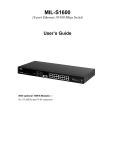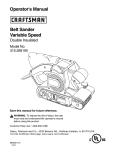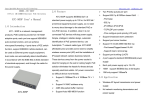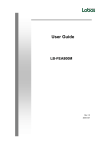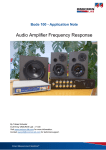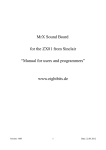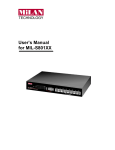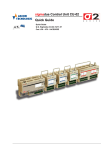Download MiLAN MIL-S1600 User guide
Transcript
MIL-S2400 & MIL-S1600 Fast Ethernet Switch 16 or 24 10/100 Mbps auto-sensing ports with optional 1 port 100Mbps Fiber Module User Guide With Optional Fiber 100BASE-TX Extension 100Base-FX with Module with SC/ST/MT-RJ/ VF-45 Multi-mode and Single-mode Regulatory Approval - FCC Class A - UL 1950 - CSA C22.2 No. 950 - EN60950 - CE - EN55022 Class A - EN55024 Canadian EMI Notice This Class A digital apparatus meets all the requirements of the Canadian Interference-Causing Equipment Regulations. Cet appareil numerique de la classe A respecte toutes les exigences du Reglement sur le materiel brouilleur du Canada. European Notice Products with the CE Marking comply with both the EMC Directive (89/336/EEC) and the Low Voltage Directive (73/23/EEC) issued by the Commission of the European Community Compliance with these directives imply conformity to the following European Norms: - EN55022 (CISPR 22) - Radio Frequency Interference EN61000-X - Electromagnetic Immunity EN60950 (IEC950) - Product Safety Five-Year Limited Warranty MiLAN Technology warrants to the original consumer or purchaser that each of it's products, and all components thereof, will be free from defects in material and/or workmanship for a period of five years from the original factory shipment date. Any warranty hereunder is extended to theoriginal consumer or purchaser and is not assignable. MiLAN Technology makes no express or implied warranties including, but not limited to, any implied warranty of merchantability or fitness for a particular purpose, except as expressly set forth in this warranty. In no event shall MiLAN Technology be liable for incidental or consequential damages, costs, or expenses arising out of or in connection with the performance of the product delivered hereunder. MiLAN Technology will in no case cover damages arising out of the product being used in a negligent fashion or manner. Trademarks © 2000 MiLAN, the MiLAN logo and MiLAN Technology are either trademarks or registered trademarks of Digi International, Inc. in the United States and/or other countries. All other trademarks are the property of their respective holders. To Contact MiLAN Technology For prompt response when calling for service information, have the following information ready: - Product serial number and revision - Date of purchase - Vendor or place of purchase You can reach MiLAN Technology technical support at: E-mail: [email protected] Telephone: +1.408.744.2751 Fax: +1.408.744.2771 MiLAN Technology 1299 Orleans Drive Sunnyvale, CA 94089-1138 United States of America Telephone: +1.408.744.2775 Fax: +1.408.744.2793 http://www.milan.com info @ milan.com © Copyright 2001 MiLAN Technology P/N: 90000372_A Contents 1. Introduction…….…………….…………….……….………….…… 1 Features …………………………………………..…..…….… 2 Package Contents ………………………..…..……….……… 3 Ethernet Switching Technology ………………….…………… 4 2. Hardware Description ………………..….…..…...………….………… 6 Front Panel ………………………………………...…...………… 6 LED Indicators ……………………………………………………. 7 Real Panel …………………………………………….………….. 8 Desktop Installation ……………………….…….……………….. 9 Rack-mounted Installation …...…………….…………………… 9 3. Optional Fiber Modules ………….…..……….…………….………… 12 Front Panel …………………………………...…...….….…..… 12 Features/ Specifications …………….………………..….……. 15 Installing 100Base-FX Module ………………………………………. 15 4. Network Application .…………………….…………… …………… 17 Small Workgroup ………………………………….......……..… 17 Segment Bridge …………….……………..…………..….……. 18 5.Troubleshooting .…………………………………..…. ……………… 20 Incorrect connections ...………………………………………… 20 Diagnosing LED Indicators ………………………..….……….. 21 6. Technical Specification .…………………….…....…. ………………… 22 Introduction Ethernet Switching Technology Ethernet Switching Technology dramatically increases the total bandwidth of a network, eliminates congestion problems inherent with ( CSMA/CD ) protocol, which greatly reduces unnecessary transmissions. Switch Technology has revolutionized networking. First, by allowing two-way, simultaneous transmissions over the same port ( Full-duplex ), which essentially doubled the bandwidth. Second, by reducing the collision domain to a single switch-port, which eliminated the need for carrier sensing. Third, by using the store-and-forward technology’s approach of inspecting each packet to prevent transmitting corrupt or redundant data, switching eliminates unnecessary transmission. By employing address-learning, the switch only transfers data to the port it is destined for. Auto-negotiation regulates the speed and duplex of each port, based on the capability of both devices. Flow-control allows transmission from a 100Mbps node to a 10Mbps node without loss of data. Autonegotiation and flow-control may require disablement for some networking operations involves legacy equipment. Disabling the auto-negotiation is accomplished by configuring the speed or duplex of a port. Ethernet Switching Technology supplies higher performance at costs lower than legacy solutions. Wider bandwidth, no congestion, and the reduction in traffic are the many reasons why switching is replacing expensive routers and inefficient hubs for the ultimate networking solution. Switching brings a whole new way of thinking to networking. The MIL-S2400 and MIL-S1600 Switches are multi-port Switches that can be used to build highperformance switched workgroup networks. These switches are store-and-forward devices that offer low latency for high-speed networking. They are targeted at workgroup, department or backbone computing environment at SME ( small, medium enterprise ) businesses. Figure 1-1. The MIL-S2400 and MIL-S1600 Switch ( Auto MDI/MDIX ) The MIL-S2400 and MIL-S1600 Switches feature a “store-and-forward “ switching scheme. This allows the switch to auto-learn and store source address on an 4K-entry MAC address table. The MIL-S2400 and MIL-S1600 Switches have 16/24 auto-sensing 10/100Base-TX RJ-45 ports plus one extension slot for ( Optional ) 100Base-FX fiber module enables long-distance connection. The optional modules support MT-RJ, SC single-mode, ST, MT-RJ, VF-45 multi-mode connectors. The fiber port can be used to connect to a remote side up to 2 Km ( multi-mode ) or 60Km ( single-mode ). Features n Conforms to IEEE 802.3, 802.3u, and 802.3x standard n 16/24x auto-sensing 10/100Mbps Ethernet RJ-45 ports n Automatic MDI/MDIX ports crossover for 10Base-T and 100Base-TX n One Extension Slot for 100Mbps Fiber modules ( Optional ) n Auto-negotiation for 10Mbps and 100Mbps n Back-Pressure-Base flow control on Half-duplex ports n Pause-Frame-Base flow control on Full-duplex ports n Store-and-forwarding switching architecture for abnormal packet filtering n Full wire speed forwarding rate n 4K-entry MAC address table n LED-indicators for Power, 10/100M, LK/ACT, Full n 19” Standard Rack-mount Package Contents Unpack the contents of the MIL-S2400 or MIL-S1600 Switch and verify them against the checklist below. n n n n n MIL-S2400 or MIL-S1600 Switch Power Cord Four Rubber Feet Rack mount kit Warranty Card Figure 1-2. Package Contents Compare the contents of your MIL-S2400 and MIL-S1600 Switches package with the standard checklist above. If any item is missing or damaged, please contact your local dealer for service. Hardware Description This Section mainly describes the hardware of the MIL-S2400 and MIL-S1600 Switches, and gives a physical and functional overview of each Switch. Front Panel The Front Panel of the MIL-S2400 and MIL-S1600 Switches consists of 16 or 24 10/100Base-TX RJ-45 ports ( Auto MDI/MDIX ) and slot for 100Base-FX Fiber Module. The LED Indicators are also located on the front panel of the Switch. Figure 2-1. The Front panel of the MIL-S2400 and MIL-S1600 Switches Optional 100Base-FX Modules: There are 5 types of 1-port 100Mbps Fiber Modules available for the MIL-S2400 and MIL-S1600 Switches. The available connectors on the 100Base-FX Module are SC, ST, MT-RJ, VF-45 ( multi-mode ) and MT-RJ, SC ( single-mode ). The distance for multimode fiber cabling can extend up to 2 kilometers. The distance for SC and MT-RJ single-mode fiber cabling is 60 kilometers. ( See Section 3. Optional Modules ) LED Indicators The LED Indicators gives a real-time information of systematic operation status. The following table provides descriptions of LED status and their meaning. Figure 2-2. LED Indicators LED Status Green Off Green Description Power On Off The port is operating at the speed of 100Mbps. 100M Off LK/ACT No device attached or in 10Mbps mode Green The port is active with device(s) attached Blinks The port is receiving or transmitting data. Off Yellow No device attached. The port is operating in full-duplex mode. Full Off No device attached or in half-duplex mode . Table 2-1. The Description of LED Indicators Rear Panel The 3-pronged power plug, On/Off switch, and ventilation fan are located at the rear panel of the MILS2400 and MIL-S1600 Switches as shown in Figure 2-2. The Switch will work in the range 100-240V AC, 50-60Hz. Figure 2-3. The Rear Panel of MIL-S2400 and MIL-S1600 Switches Desktop Installation A. Set the Switch on a sufficiently large flat space with a power outlet nearby. The surface where you put your Switch should be clean, smooth, level and sturdy. B. Make sure there is enough clearance around the Switch to allow attachment of cables, power cord and allow air circulation. Attaching Rubber Feet A. B. C. Make sure mounting surface on the bottom of the Switch is grease and dust free. Remove adhesive backing from rubber feet. Apply the rubber feet to each corner on the bottom of the Switch. Figure 2-4. Attach rubber feet to each corner on the bottom of the Switch Rack-mounted Installation The MIL-S2400 and MIL-S1600 switches includes a rack-mounted kit and can be mount in an EIA standard size, 19-inch Rack, enabling the switch to be placed in a wiring closet with other equipment. Perform the following steps to rack mount the switch: A. Position one bracket to align with the holes on one side of the switch and secure it with the smaller bracket screws. Then attach the remaining bracket to the other side of the switch. Figure 2-4. Attach mounting brackets with screws B. After attaching both mounting brackets, position the MIL-S2400 and MIL-S1600 Switches in the rack by lining up the holes in the brackets with the appropriate holes on the rack. Secure the switch to the rack with a screwdriver and the rack-mounting screws. Figure 2-5. Mount the MIL-S1600 Switch in an EIA standard 19-inch Rack Note: For proper ventilation, allow about at least 4 inches ( 10 cm ) of clearance on the front and 3.4 inches ( 8 cm ) on the back of the switch. This is especially important for enclosed rack installation. Power On Connect the power cord to the power socket on the rear panel of the switch. Connect the other end of the power cord to the power outlet. The internal power supply of the switch works with AC in the voltage range 100-240VAC, frequency 50~60Hz. Check the power indicator on the front panel to see if power is properly supplied. Optional Fiber Modules This section introduces the optional 100Base-FX Modules which can be installed on the front panel of the MIL-S2400 and MIL-S1600 Switches. Each optional 100Base-FX Module has a oneport fiber connector. The 100Base-FX Modules are designed to extend the distance between switch and other devices. The maximum distance connected by optical fiber is up to 2 Km ( multi-mode fiber ) or 60 Km ( single-mode fiber ). Figure 3-1. The optional 100Base-FX Module You can regard this fiber port as backbone in the networking infrastructure. There are four types of fiber port connectors available including ST, SC, MT-RJ, VF-45 multi-mode and SC and MT-RJ single-mode connectors. The following is the introduction about them. Front Panel The Front Panels of the 100Base-FX Modules consist of four LED-indicators, two thumbscrews, DIP-switch, and one fiber port. An example of each of the Front Panels of the 100Base-FX Modules are illustrated. Model number and serial number can be found on a label on the underside of the module. MIL-L1624SC MIL-L1624SC-60 MIL-S2416ST MIL-S2416MT MIL-S2416VF LED Indicators of 100base-FX The LED-Indicators provide a real-time information of systematic operation status. The following table provides descriptions of LED Indicators status and their meaning. LED Status Blinks Off Blinks Description This fiber port is transmitting data. No data is be transmitted. This fiber port is receiving data. RX Off Yellow No data is being received. The port is connecting with the device. Link Off FD/COL No device attached. Yellow The port is operating in Full-duplex mode. Blinks Collision of is occuring Off No device attached or in half-duplex mode . Table 3-1. The Description of LED-Indicators on 100Base-FX Modules Features / Specifications of the 100Base-FX n Conforms to IEEE 802.3u 100Base-FX & 802.3x Full Duplex Flow Control standard n One-port 100Mbps optical fiber module n LED-indicators for TX, RX, Link, and FDX/COL (4 LEDs) n One DIP-switch to select fiber port for Full-duplex or Half-duplex. n Max. Forwarding Rate: 148810 pps for 100Base-FX (Wire speed) n Dimensions: 102mmx 71mmx 24mm ( 4” x 2.8” x 1” ) n Weight : 60 ±5g n Operating Temperature : 0 ~ 45 C (31 ~ 113 F) n Environment Humility : 10% ~90% ( Non-condensing ) n EMI : FCC Class A, CISPR 22 Class A n Safety: UL, cUL and TUV Installing 100Base-FX Module The optional 100Base-FX Modules are designed to be inserted in the extension slot. Before installation, ensure that the power is disconnected. The module is NOT hot-swappable. Follow the steps below to install the optional 100Base-FX Module: 1. Power the MIL-S2400 and MIL-S1600 Switches OFF before installing the 100Base-FX Module. 2. Unscrew the thumbscrews on the blank bracket. Remove the blank bracket and set aside, but do not discard it. Replace the blank bracket if you should remove the fiber module. 3. Install the new 100Base-FX Module by inserting it into the guides and sliding it in until it stops ( See Figure 3-7 ). Press it firmly until you feel the module snap into place. Never force, twist or bend the 100Base-FX Module. Figure 3-7. Install the 100Base-FX Module by inserting it into the guides and sliding it in until it stops 4. Gently push the thumbscrews in and turn clockwise to tighten. Do not over tighten the thumbscrews. 5. Power MIL-S2400 and MIL-S1600 Switches ON, and the Switch will automatically detect the 100Base-FX Module. Plug the fiber cable connector into the 100Base-FX Module. Check the LEDs to verify that if there is a link and proper connection. Troubleshooting This section is intended to help you solve the most common problems on the MIL-S2400 and MILS1600 Switches. n Faulty or loose cables Look for loose or obviously faulty connections. If they appear to be OK, make sure the connections are snug. IF that does not correct the problem, try a different cable. n Non-standard cables Non-standard and miswired cables may cause numerous network collisions and other network problem, and can seriously impair network performance. A category 5 cable tester is a recommended tool for every 100Base-TX network installation. n Improper Network Topologies It is important to make sure that you have a valid network topology. You should make sure that your network topology contains no data path loops. Between any two ends nodes, there should be only one active cabling path at any time. Data path loops will cause broadcast storms that will severely impact your network performance. Diagnosing LED Indicators The Switch can be easily monitored through panel indicators to assist in identifying problems, which describes common problems you may encounter and where you can find possible solutions. If the power indicator does turn on when the power cord is plugged in, you may have a problem with power outlet, or power cord. However, if the Switch powers off after running for a while, check for loose power connections, power losses or surges at power outlet. If you still cannot resolve the problem, contact your local dealer for assistance. n Cabling A. RJ-45 ports: Use unshielded twisted-pair (UTP) or shield twisted-pair ( STP ) cable for RJ45 connections: 100O Category 3, 4 or 5 cable for 10Mbps connections or 100O Category 5 cable for 100Mbps connections. Also be sure that the length of any twisted-pair connection does not exceed 100 meters ( 328 feet ). B. 100Base-FX fiber port: Fiber multi-mode connector type must use 50,62.5/125 um multimode fiber cable. You can connect two devices over a 2-kilometer distance. However, Fiber single-mode connector type must use 9/125 um single- mode fiber cable. You can connect two devices over a 60- kilometer distance in full duplex operation. Technical Specification This section provides the specifications for the MIL-S2400 and MIL-S1600 Switches. Specifications Standard IEEE 802.3 10Base-T Ethernet, IEEE 802.3u 100Base-TX/FX Fast Ethernet Protocol CSMA/CD Max Forwarding Rate and Max Filtering Rate 14,880 pps per Ethernet port, 148,800 pps per Fast Ethernet port LED Indicators 10/100 UTP Port: 100M, LK/ACT, Full ( 3 LEDs) 100M Fiber Port: TX, RX, Link, FD/COL ( 4 LEDs) Per Unit: Power Copper Network Cables 10Base-T: 2-pair UTP/STP Cat. 3, 4, 5 cable EIA/TIA-568 100-ohm (100m ) 100Base-TX: 2-pair UTP/STP Cat. 5 cable EIA/TIA-568 100-ohm (100m ) Fiber Link Max. Distance ST, SC, MT-RJ, VF-45 Multi-mode: Half-duplex- 412m , Full-duplex- 2Km MT-RJ/SC Single-mode: Half-duplex- 412m , Full-duplex- 60Km Dimensions MIL-S1600 +1Fiber Module Switch : 440mm x 160mm x 44mm ( L x W x H ) 17.4” x 6.3” x 1.75” MIL-S2400 +1Fiber Module Switch : 440mm x 160mm x 44mm ( L x W x H ) .95” 100Base-FX Module : 102mm x 71mm x 24mm ( L x W x H ) Weight 16TP+1Fiber Module Switch : 2.2 Kg 4.85 lbs 24TP+1Fiber Module Switch : 2.3 K 5 lbs 100Base-FX Module : 60 ±5g .14 lbs Storage Temp. -40ºC to 70ºC ( -40ºF to 158ºF) Operational Temp. 0ºC to 45ºC ( 32ºF to 113ºF ) Operational Humidity 10% to 90% (Non-condensing) External Power 100-240V AC, 50-60Hz Output rate: +5V/2A, +3.3V/8A Power Consumption MIL-S1600 :10 Watts ( Max ) MIL-S2400 :13 Watts ( Max ) EMI FCC Class A, CISPR 22 Class A, CE Mark Safety UL, cUL and TUV P/N: 90000372_A
















